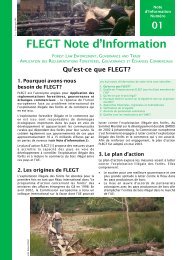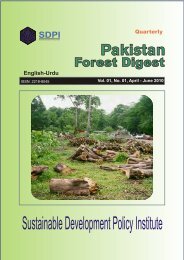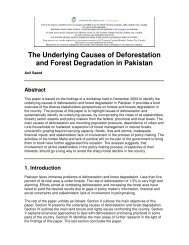CHAINSAW MILLING IN GHANA: CONTExT, DRIVERS ... - Fornis.net
CHAINSAW MILLING IN GHANA: CONTExT, DRIVERS ... - Fornis.net
CHAINSAW MILLING IN GHANA: CONTExT, DRIVERS ... - Fornis.net
- No tags were found...
You also want an ePaper? Increase the reach of your titles
YUMPU automatically turns print PDFs into web optimized ePapers that Google loves.
Chainsaw milling in Ghana: context, drivers and impactsit could be assumed to be high since about 74% of farmers indicated they knew theoperators. Furthermore, farmers also indicated that about 44% of the operators livedand operated within their own communities (Nutakor and Marfo 2009).When logging occurred without prior consultation with the farmer, Nutakor andMarfo (2009) reported that most farmers (87%) eventually got to know the operatorswho did the logging; about 10% of them never knew who had done so.Nutakor and Marfo (2009) showed that for 58% of farmers, bargaining with theoperator was the most common method used to arrive at a settlement. In a few casesthe farmer fixed the price; generally, the operator did so.Perhaps surprisingly, 77% of farmer-operator conflicts were reported to have beenresolved (Nutakor and Marfo 2009). According to farmers’ claims, 47% of the caseswere peacefully resolved, while in about 30% of the cases, force and mediatedbargaining had to be used. More than 90% of cases as reported by operators werepeacefully settled; they may not have been settled directly with the farmers, as thisrate is higher than the 77% reported by farmers. The wide variance between the tworates may indicate some dissatisfaction on the part of owners/farmers. In cases wheresome engagement and bargaining was involved, 59% of farmers reported that thepromised amount was paid. This is better than the 15%, 17% and 38% settlementrates observed by Marfo (2006), 14 Ardayfio-Schandorf et al. (2007) and Marfo,Acheampong and Osae 2006, respectively.Operators reported that a little more than 60 hours (about three full days) wererequired to be able to resolve specific conflicts. This is significant and could befrustrating for both farmers and operators.Other studies, including Adam et al. (2007a) and Marfo, Acheampong and Osae(2006), have observed that conflict exists but is probably minimal since communitiesand farmers are likely to benefit more from CSM operations than from conventionallogging. Adam et al. (2007a) also report that 62% of operators had no problemswith communities. About 7% of the respondents, including farmers, chiefs andassembly representatives, mentioned that conflict, vandalism and a breakdown inlaw and order were some of the social costs of the illegal chainsaw operations in theircommunities.5.1.4 Operator-FSD conflictCSM has a significant impact on official monitoring resources. There is a huge costto the enforcement agencies in terms of time; Marfo and Nutakor (2009) reportedthat FSD officials made an average of seven court appearances for each case, each ofwhich lasted at least three hours. Marfo and Nutakor (2009) also reported that casestook an average two months in court and the number of adjournments was veryhigh (19 times in some reported cases; see Inkoom 1999; Owusu 2004). Marfo andNutakor (2009) further observed that most officials said they spent 25–75% of theirtime on chainsaw-related matters. This takes them away from their other duties.40
















